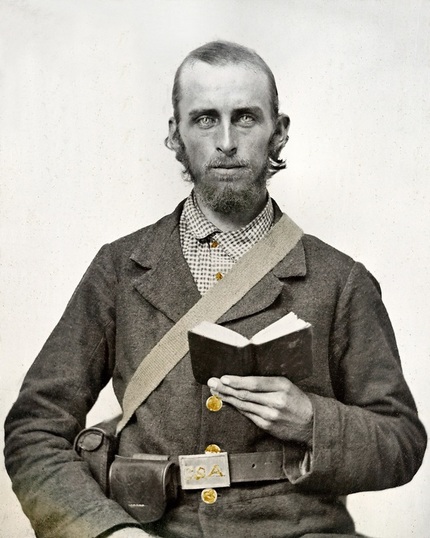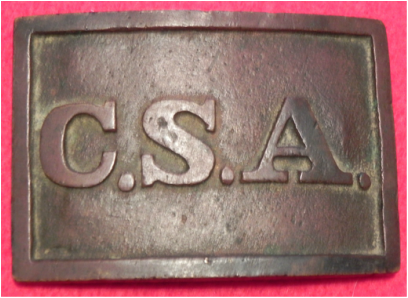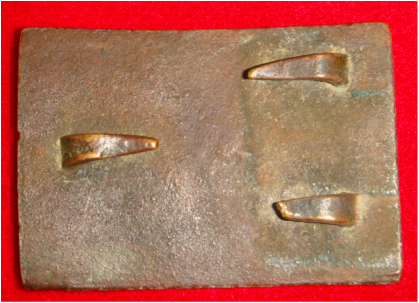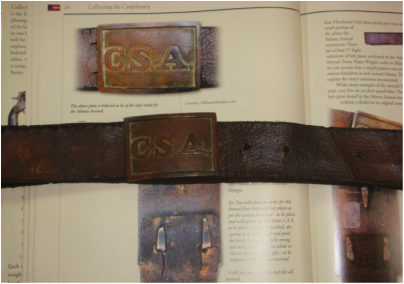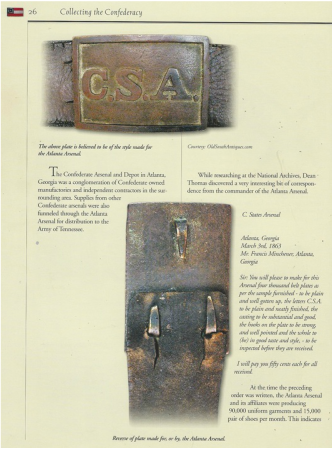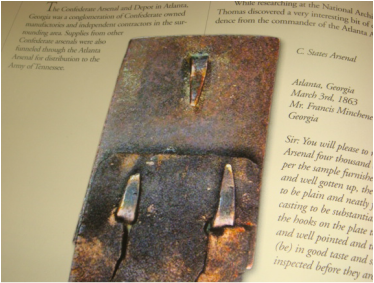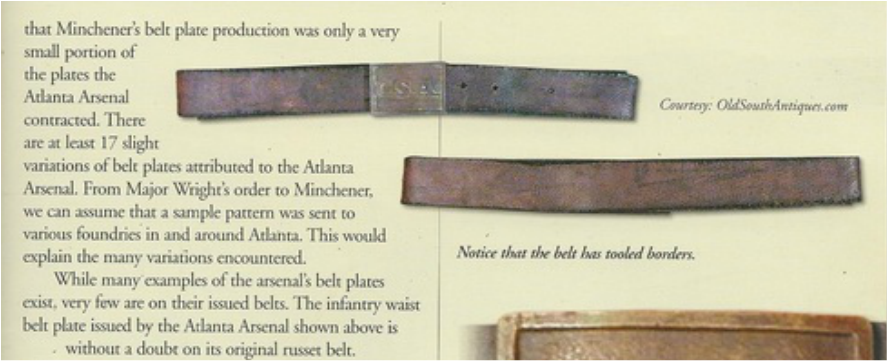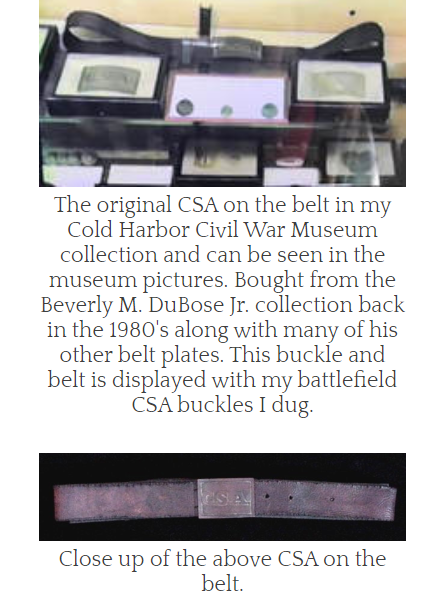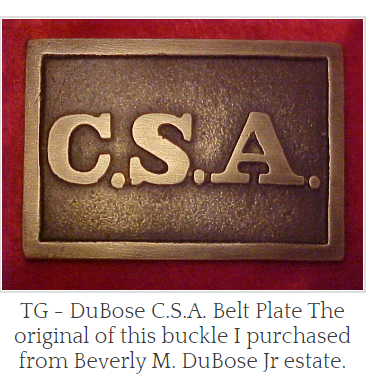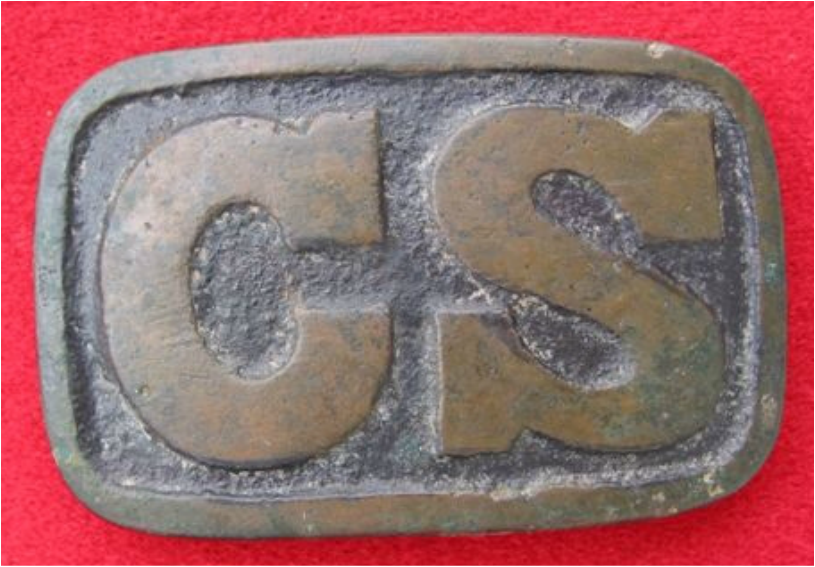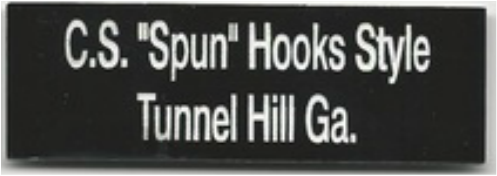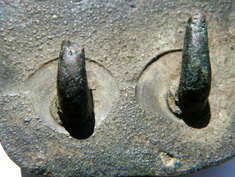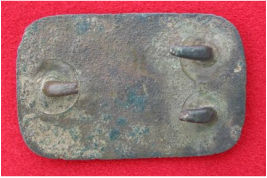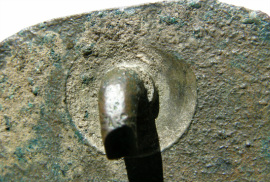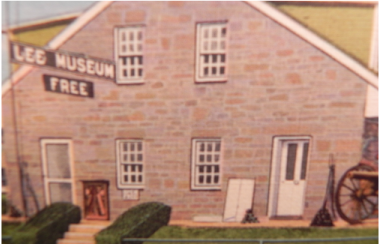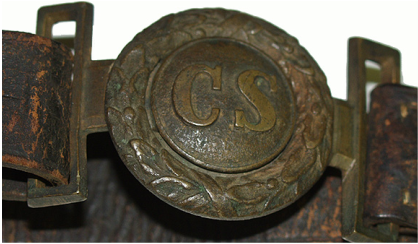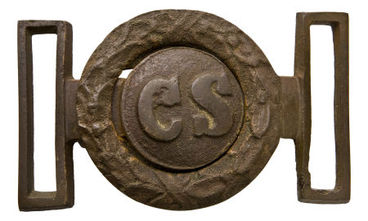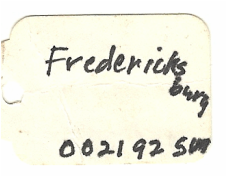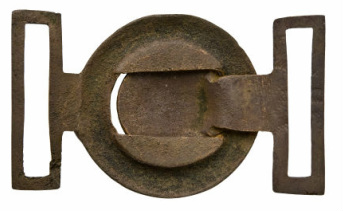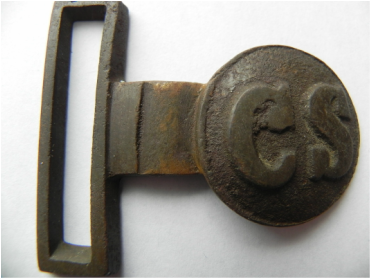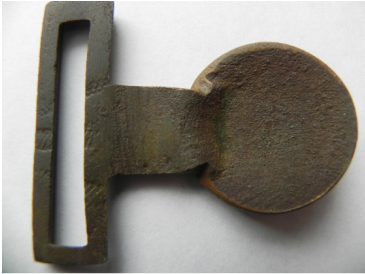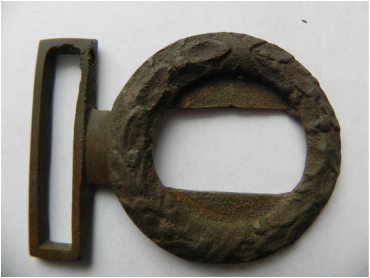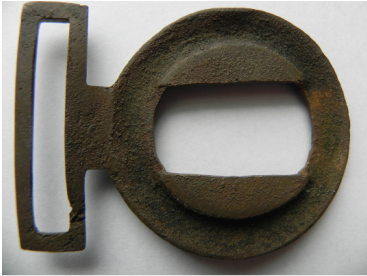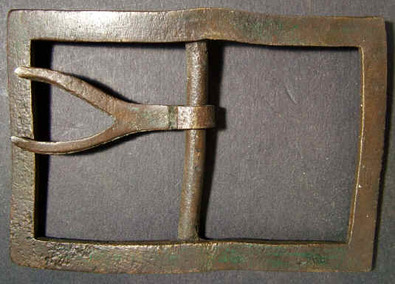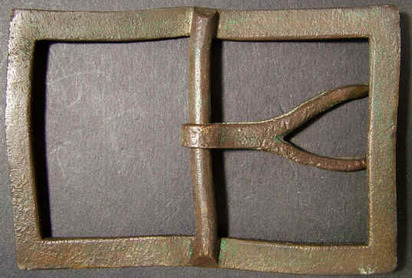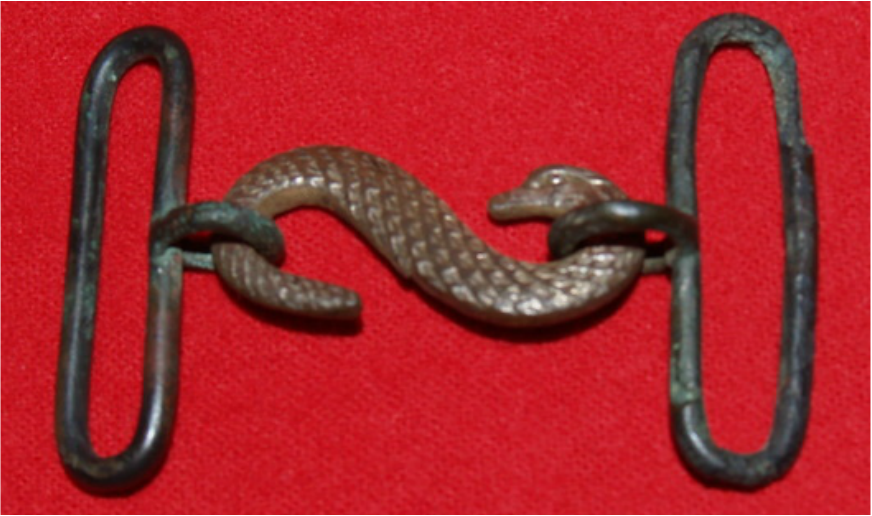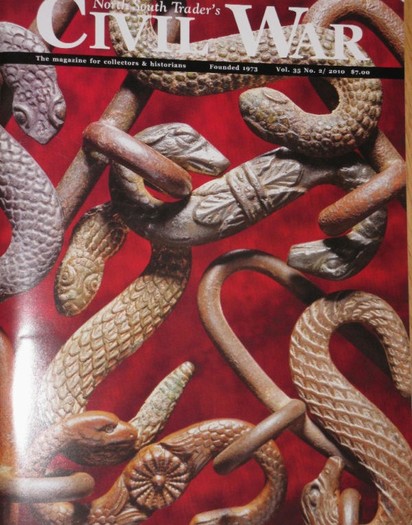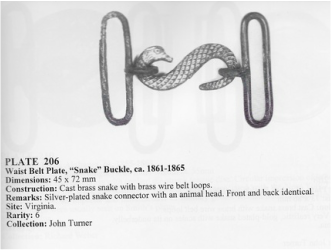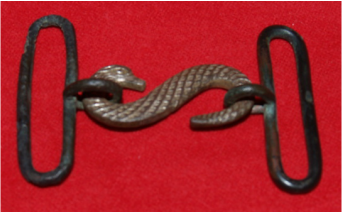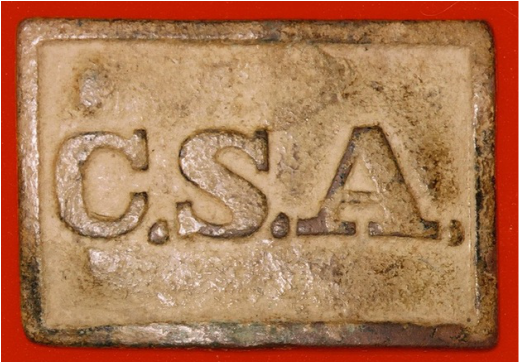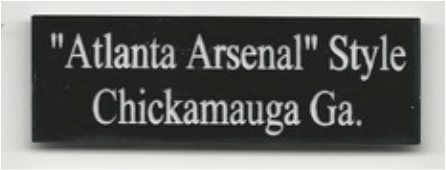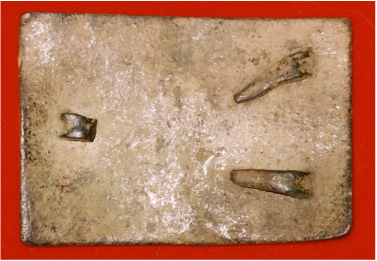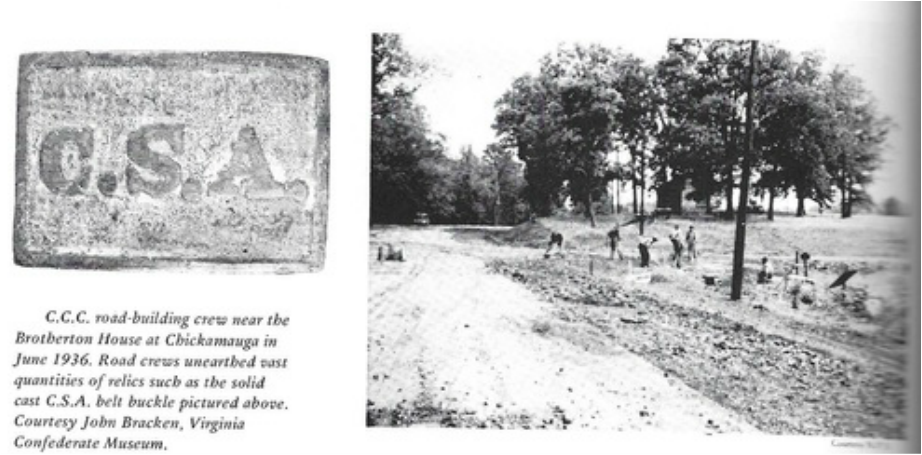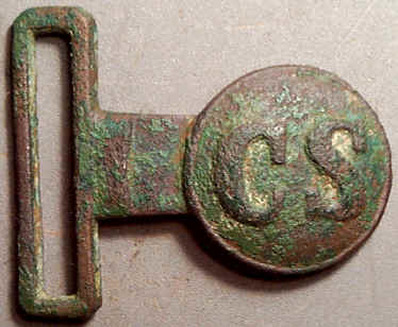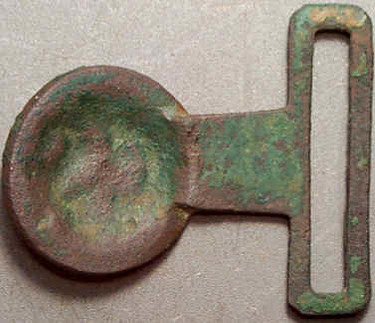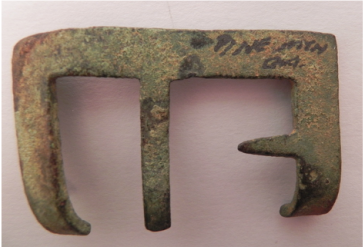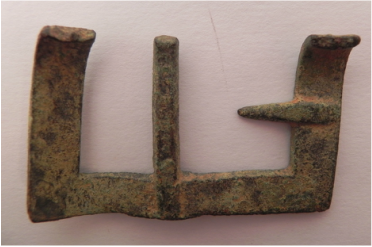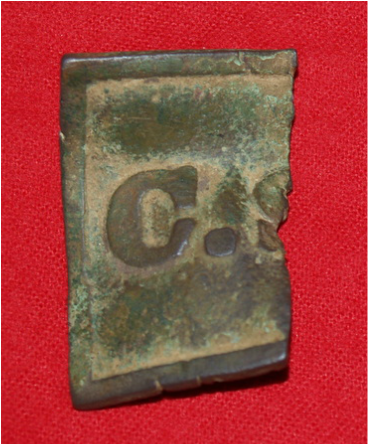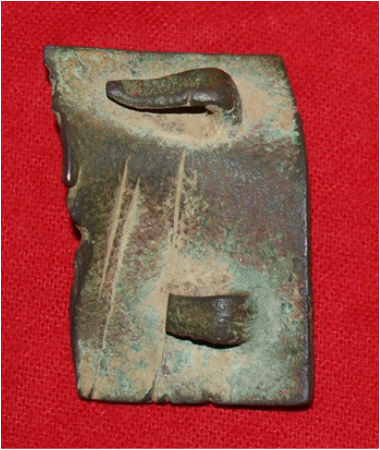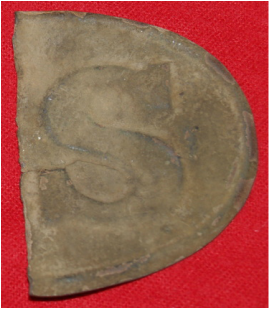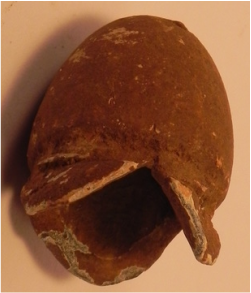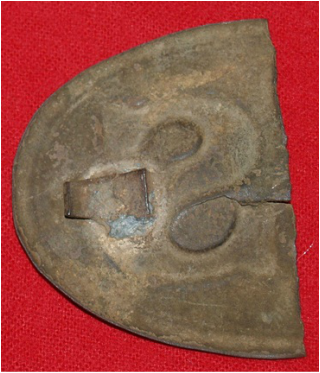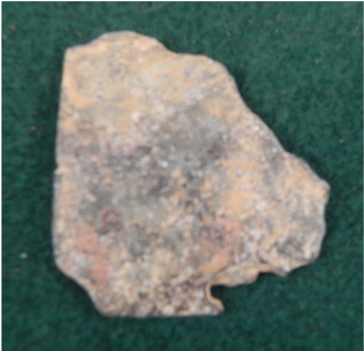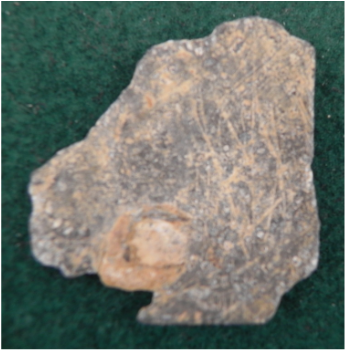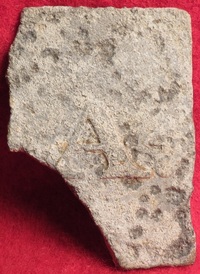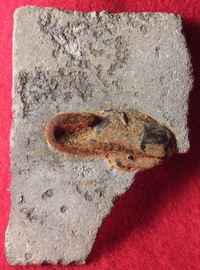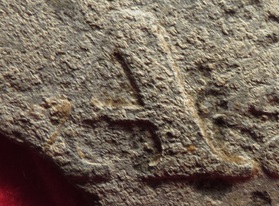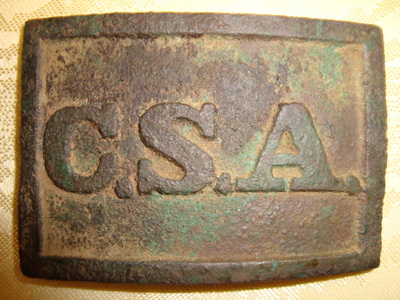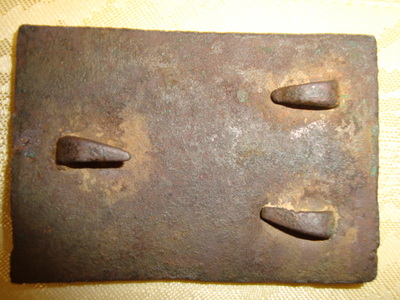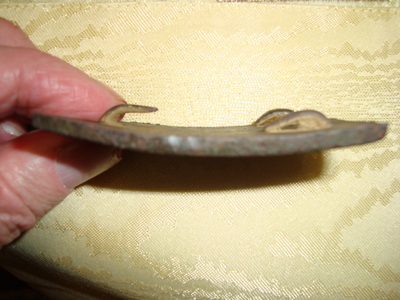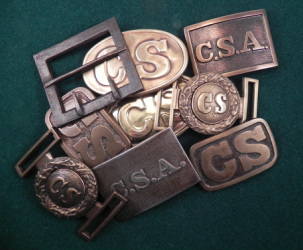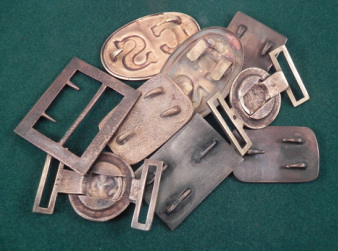Confederate Buckles and Plates
ATLANTA PLATE ON ORIGINAL BELT
"COLLECTING THE CONFEDERACY" PAGE 26
"COLLECTING THE CONFEDERACY" PAGE 27
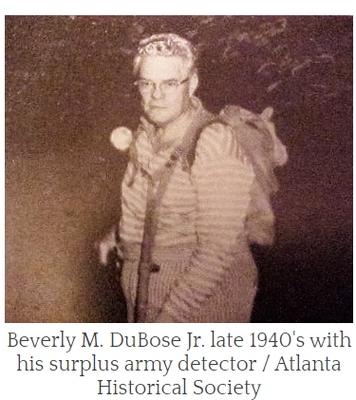
This is the exact Atlanta Arsenal and Depot belt and plate published on pages 26 and 27 of Shannon Pritchard's book "Collecting the Confederacy". This infantry waist belt plate is, as Mr. Pritchard stated, "without a doubt on its original russet belt". The actual shadowing from the leather can clearly be seen in the back of the plate. The "pig skin" belt is classic Confederate right down to the tooled border and the crude hook-holes differing in size, shape, spacing and centering.This belt was, at one time, part of the late Beverly Dubose collection in Atlanta and was ultimately purchased by Gary Williams many years ago. The belt was displayed in his Cold Harbor museum in Williamsburg until he closed the doors in 1995. Mr. Williams stated that it was one of his favorite items because "it is so difficult to get a buckle and belt that has truly always been together". You can still see an image of the belt in one of his museum pictures if you go to his "Hanover Brass' site and is shown in the picture on the left. It was also part of Michael Kramer's collection at the time of its inclusion in the Pritchard book.The buckle is in perfect un-dug condition with a great patina. The plate measures 48.6 mm x 69.5 mm and shows the "textbook" sand-inclusions from the sand casting process. All three hooks are intact and the plate shows the filing marks from the post-casting process. The CS russet leather belt with the tooled edging and its buckle are rare survivors of the Civil War.
(Reference: "Confederate Belt Buckles and Plates, Expanded Edition " by Steve E. Mullinax, plates 84-101; "The Illustrated History of American Civil War Relics" by Stephen W. Sylvia & J. O'Donnell, page 24, 36, 207, 306; "Plates and Buckles of the American Military 1795-1874" by Sydney C. Kerksis, pages 306-316, 488; "Accoutrement Plates, North and South 1861-1865" by William G. Gavin, pages 96-108; "Accoutrement Plates North and South 1861-1865" by William G. Gavin, pages 97-107; "Arms and Equipment of the Confederacy" by Time-Life Books, page 195; "Civil War Relics from Georgia" by Celeste C. Topper and David Topper, page 53).
(Reference: "Confederate Belt Buckles and Plates, Expanded Edition " by Steve E. Mullinax, plates 84-101; "The Illustrated History of American Civil War Relics" by Stephen W. Sylvia & J. O'Donnell, page 24, 36, 207, 306; "Plates and Buckles of the American Military 1795-1874" by Sydney C. Kerksis, pages 306-316, 488; "Accoutrement Plates, North and South 1861-1865" by William G. Gavin, pages 96-108; "Accoutrement Plates North and South 1861-1865" by William G. Gavin, pages 97-107; "Arms and Equipment of the Confederacy" by Time-Life Books, page 195; "Civil War Relics from Georgia" by Celeste C. Topper and David Topper, page 53).
INFORMATION BELOW IS TAKEN FROM HANOVER BRASS WEBSITE
TENNESSEE ROUND CORNER
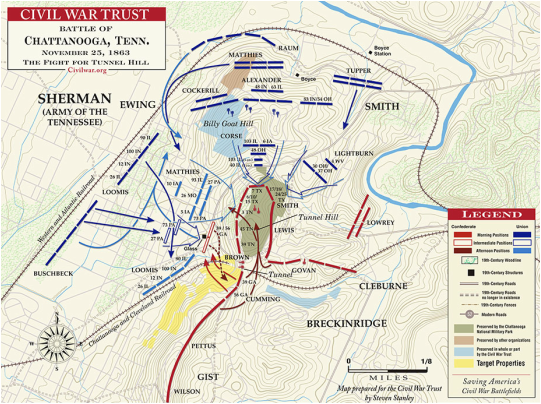
This solid cast plate referred to as a Tennessee round corner "spun hooks" plate was excavated out of Tunnel Hill, Georgia by Ashley Cook of Ft. Oglethorpe Ga. in February of 1980.
"To pry the Confederates out of their position on Missionary Ridge, General Ulysses S. Grant planned to attack the Confederate line on both flanks. General Joseph Hooker would strike the southern end of Missionary Ridge while General William T. Sherman's troops attacked the northern end of the Confederate line at Tunnel Hill. On the morning of November 25, 1863, Sherman launched a series of piecemeal attacks against General Patrick R. Cleburne's division on Tunnel Hill, with no success."
This distinctive style plate was mainly issued to the Army of Tennessee. This example is in wonderful condition retaining 90% original black enamel and all three hooks except the tips which are clearly casting flaws. This relic has the vividly clear "CS" that takes up most of the face of the plate. The plate measures 46 mm X 71 mm. It was dug in an area of great historic battles fought during campaign for Atlanta including Battle of Rocky Face, Battle of Dug Gap and Battle of Resaca. Another of the clipped corner pattern buckles found in this same patch of ground is displayed nicely on page 201 of Charles S. Harris’s great book “Civil War Relics of the Western Campaigns”. Mr. Harris was kind enough to confirm the story of its find. He states that Ashley and his hunting partner got into a briar patch with permission from the land owner and were wearing heavy duck hunting clothes so were not bothered by the briars. They then got permission from the farmer to 'bush hog' the briar patch and recovered more buckles. After the site was fully worked they got permission to doze off about six inches and made more recoveries. After all was done, the farmer let the site grow back over the briars..
The stories surrounding the discovery and the theories as to why so many buckles were uncovered in such a small area is as fascinating as the artifact itself. One opinion is that the area was one of General Joe Wheeler’s camps around May of 1864 and the low area was, at the time, a pond. The rebels were taking their yearly bath when the Yankees attacked and chased them into the hills without having the opportunity to collect their accoutrements. Great story, but no matter how long I stare at that buckle it refuses to share the mystery as to why multiple plates came to rest in that small briar patch a century and a half ago. (I strongly recommend Charlie Harris's book to anyone interested in the Civil War). Ashley Cook himself shared some details with me and the following is a copy of a portion his correspondence ; "Ron,The site was by the W&A railroad on the west side of Tunnel Hill. I found 4 CS clip corners,1 cs plate,1 CSA plate, 1 CS wreath plate,1 wire 3 hook breast plate. There was three of us in all. My partners also found clip corners and CSA plates.The best find was a solid cast small CS oval plate. That one was the first I ever saw. Lots of solid cast I buttons came out of the site." I had the privilege to talk to Ashley and he was kind enough to share the fascinating story in detail. The willingness of Mr. Harris and Mr. Cook to take the time to share their knowledge and experience will forever be appreciated and I can't thank them enough for bringing this buckle to life.True gentlemen such as these add so much to the pure joy of collecting.
(Reference: “Confederate Buckles & Plates, Expanded Edition”, by Steve Mullinax, pages 74-76; "Plates and Buckles of the American Military 1795-1874" by Sydney C. Kerksis, pages 300, 486; "Accoutrement Plates, North and South 1861-1865" by William G. Gavin, pages 109-110; "Confederate Arms" by William A. Albaugh !!! and Edward N. Simmons, page 176; "The Illustrated History of American Civil War Relics" by Stephen W. Sylvia & J. O'Donnell, page 67; "Accoutrement Plates North and South 1861-1865" by William G. Gavin, page 110; "Civil War Artifacts A Guide to The Historian" by Howard Crouch, page 206; "Civil War Relics of the Western Campaigns" by Charles S. Harris, page 130, 149, 165, 146, 165, 201, 202, 215, 237; "Arms and Equipment of the Confederacy" by Time-Life Books, page 199; " Confederate Arms" by William A. Albaugh lll and Edward N. Simmons, page 176; "Excavated Artifacts from Battlefields and Campsites of the Civil War 1861-1865" by Stanley S. Phillips, page 46)
"To pry the Confederates out of their position on Missionary Ridge, General Ulysses S. Grant planned to attack the Confederate line on both flanks. General Joseph Hooker would strike the southern end of Missionary Ridge while General William T. Sherman's troops attacked the northern end of the Confederate line at Tunnel Hill. On the morning of November 25, 1863, Sherman launched a series of piecemeal attacks against General Patrick R. Cleburne's division on Tunnel Hill, with no success."
This distinctive style plate was mainly issued to the Army of Tennessee. This example is in wonderful condition retaining 90% original black enamel and all three hooks except the tips which are clearly casting flaws. This relic has the vividly clear "CS" that takes up most of the face of the plate. The plate measures 46 mm X 71 mm. It was dug in an area of great historic battles fought during campaign for Atlanta including Battle of Rocky Face, Battle of Dug Gap and Battle of Resaca. Another of the clipped corner pattern buckles found in this same patch of ground is displayed nicely on page 201 of Charles S. Harris’s great book “Civil War Relics of the Western Campaigns”. Mr. Harris was kind enough to confirm the story of its find. He states that Ashley and his hunting partner got into a briar patch with permission from the land owner and were wearing heavy duck hunting clothes so were not bothered by the briars. They then got permission from the farmer to 'bush hog' the briar patch and recovered more buckles. After the site was fully worked they got permission to doze off about six inches and made more recoveries. After all was done, the farmer let the site grow back over the briars..
The stories surrounding the discovery and the theories as to why so many buckles were uncovered in such a small area is as fascinating as the artifact itself. One opinion is that the area was one of General Joe Wheeler’s camps around May of 1864 and the low area was, at the time, a pond. The rebels were taking their yearly bath when the Yankees attacked and chased them into the hills without having the opportunity to collect their accoutrements. Great story, but no matter how long I stare at that buckle it refuses to share the mystery as to why multiple plates came to rest in that small briar patch a century and a half ago. (I strongly recommend Charlie Harris's book to anyone interested in the Civil War). Ashley Cook himself shared some details with me and the following is a copy of a portion his correspondence ; "Ron,The site was by the W&A railroad on the west side of Tunnel Hill. I found 4 CS clip corners,1 cs plate,1 CSA plate, 1 CS wreath plate,1 wire 3 hook breast plate. There was three of us in all. My partners also found clip corners and CSA plates.The best find was a solid cast small CS oval plate. That one was the first I ever saw. Lots of solid cast I buttons came out of the site." I had the privilege to talk to Ashley and he was kind enough to share the fascinating story in detail. The willingness of Mr. Harris and Mr. Cook to take the time to share their knowledge and experience will forever be appreciated and I can't thank them enough for bringing this buckle to life.True gentlemen such as these add so much to the pure joy of collecting.
(Reference: “Confederate Buckles & Plates, Expanded Edition”, by Steve Mullinax, pages 74-76; "Plates and Buckles of the American Military 1795-1874" by Sydney C. Kerksis, pages 300, 486; "Accoutrement Plates, North and South 1861-1865" by William G. Gavin, pages 109-110; "Confederate Arms" by William A. Albaugh !!! and Edward N. Simmons, page 176; "The Illustrated History of American Civil War Relics" by Stephen W. Sylvia & J. O'Donnell, page 67; "Accoutrement Plates North and South 1861-1865" by William G. Gavin, page 110; "Civil War Artifacts A Guide to The Historian" by Howard Crouch, page 206; "Civil War Relics of the Western Campaigns" by Charles S. Harris, page 130, 149, 165, 146, 165, 201, 202, 215, 237; "Arms and Equipment of the Confederacy" by Time-Life Books, page 199; " Confederate Arms" by William A. Albaugh lll and Edward N. Simmons, page 176; "Excavated Artifacts from Battlefields and Campsites of the Civil War 1861-1865" by Stanley S. Phillips, page 46)
GETTYSBURG BUCKLE ON ORIGINAL BELT
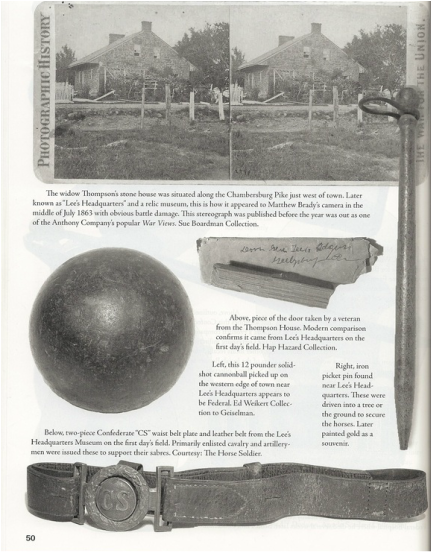 PAGE 50 OF MIKE O'DONNELL BOOK
PAGE 50 OF MIKE O'DONNELL BOOK
This artifact is from the Lee’s Headquarters Collection which is one of the oldest private collections in Gettysburg, having opened to public view in 1926. A relic from the Gettysburg battlefield, this two piece CS buckle and original 1 ¼” wide black cowhide belt has an accompanying printed plastic label (shown above) which replaced the original handwritten label when the museum display was re-arranged and updated by the Larson family (owners from 1945 to 1995) in the 1970’s. The house was built in 1834 and at the time of the Civil War was owned by the noted statesman Thaddeus Stevens. It was on July 1, 1863 that General Robert E. Lee established his personal headquarters in this old stone house. An ideal location, it was at the center and rear of his battle lines and it was on the same road that many more of his troops were quickly approaching. At the time of the battle, the house was the dwelling place of Mrs. Mary Thompson, who was known as the "widow" Thompson. She was not excited about her house occupied by a "rebel", but she testified that the deportment of General Lee whilst in her house was gentlemanly, but complains bitterly of the robbery and general destruction of her goods by some of his attendants". In the spring of 1922 the house was opened to the public as the Lee Museum by C.F. Daley who began displaying artifacts and relics found on the battlefield and brought back to town by visiting veterans. Since that time, the museum has been in continuous operation and remains one of the oldest museums in Gettysburg.This Confederate belt and buckle was, for many years, the centerpiece among a grouping of Gettysburg relics in an outdoors shadow box display next to the museum entrance. I have a letter from one of the previous owners of the belt stating that he first noticed the belt in 1949 when he saw it in that relic box display on the outside of the Museum. He stated that the fold creases in the belt are quite prevalent and still conform with the manner in which it was folded in the relic box. The portable box was near the west door entrance and secured to the wall by only a simple eye and hook latch (see photo of museum above). As far as he knew, it remained out there permanently. He correctly quipped “can you imagine how long that would have lasted today”. You can see the box in numerous post card photos published about 1949. The display box was probably removed in the 1970’s when the museum display was rearranged and inventoried by the Larsons. The previous owner of the belt goes on to say that he inquired about the belt when the Larson family sold the museum to the Monahans. Andy Larson stated that the belt in the box with other relics was on external display when his father bought the motel/museum in the1940’s. Andy stated that it and all the other museum items had been accumulated by Clyde Daley since the early 1920’s. Since it’s stay in the Lee’s Hqs. Museum the belt has had two collector owners prior to myself. This is the exact belt pictured on page 50 in Mike O’Donnell’s excellent new book “Gettysburg Battlefield Relics and Souvenirs”. I purchased this item from the Horse Soldier along with the original label and letter of authenticity from Was Small. Given its history, the leather, although stiff, is in remarkable condition. A split has been professionally repaired and if not mentioned would be difficult to find. (see a couple of additional pictures of this belt in the Gettysburg section).
(Reference: "The Illustrated History of American Civil War Relics" by Stephen W. Sylvia & J. O'Donnell, page 24, 36, 70; “ Confederate Belt Buckles and Plates, Expanded Edition " by Steve E. Mullinax, page 2; “Plates and Buckles of the American Military 1795-1874” by Sydney C. Kerksis, page 272, 449, 488; “ Collecting the Confederacy” by Shannon Pritchard, page 23; "Accoutrement Plates North and South 1861-1865" by William G. Gavin, pages 115- 126; "Civil War Collector's Encyclopedia", Volume IV, by Francis A. Lord, page 16)
TWO-PIECE BUCKLE FROM FREDRICKSBURG
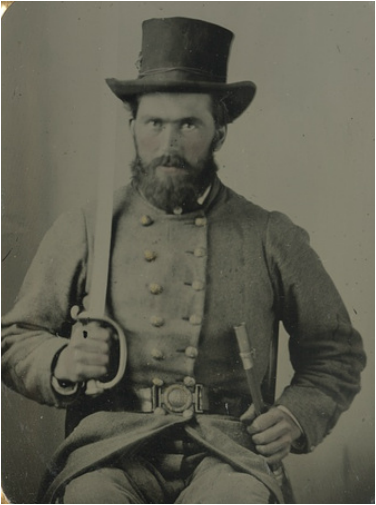
Battlefield recovered Virginia Theater Confederate Two Piece Interlocking waist belt buckle. These buckles were primarily used for sword belts issued to the cavalry of the Army of Northern Virginia and to a lesser extent, officers of that army.This sand cast plate features the exaggerated serifs which is one of the more attractive of the Virginia style, two piece buckles.There is some ground action but you can still see the file marks and sand casting. It measures a full first generation size of 48.40 mm x 82 mm. and has a nice untouched relic condition with deep rich color. It is absolutely original and not a marriage. A Mullinax tag accompanying the buckle identifies it as having been found at Fredericksburg and comes with a letter of authenticity from Mr. Mullinax. Of course, Mr. Mullinax was the preeminent Confederate Buckle expert and author of the Confederate Buckle "bible".
"The Battle of Fredericksburg, fought December 11-15, 1862, was one of the largest and deadliest of the Civil War. It featured the first major opposed river crossing in American military history. Union and Confederate troops fought in the streets of Fredericksburg, the Civil War’s first urban combat. With nearly 200,000 combatants, no other Civil War battle featured a larger concentration of soldiers."
(Reference: “Confederate Buckles & Plates ,Expanded Edition ” by Steve Mullinax, plate 006; “Plates and Buckles of the American Military 1795-1874” by Sydney C. Kerksis, page 264; "Accoutrement Plates North and South 1861-1865" by William G. Gavin, pages 115- 126; "Civil War Artifacts A Guide to The Historian" by Howard Crouch, page 207; "Civil War Relics of the Western Campaigns" by Charles S. Harris, page 101; " Confederate Arms" by William A. Albaugh lll and Edward N. Simmons, page 174)
FORKED TONGUE
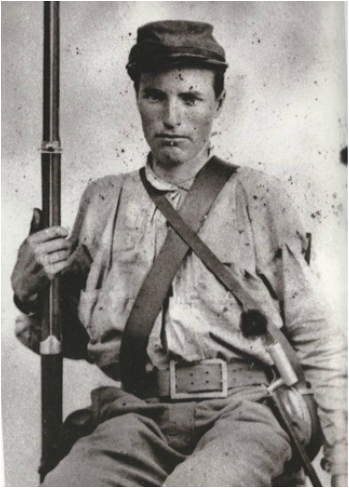
This is the large size solid brass CS buckle measuring 65 mm x 96 mm with a slight bend on the right side. It has a very nice greenish patina. Once part of the John Turner frame buckle collection which was purchased directly by Brian Banks in about 2000. Mr. Banks did some sort of trade with a picker who took it to Harry Ridgeway who sold it to me. Each of the Turner buckles had a small paper tag underneath it in the collection. Only a few of the collection were identified as to location of find. Fortunately,this one was one that came with an identification tag which simply reads "Franklin".
"After failing to destroy John Schofield’s Federal army near Spring Hill the previous morning, Gen. John Bell Hood led his 30,000 Confederates to the outskirts of Franklin, Tennessee on November 30, 1864. Determined not to let Schofield reach the safety of Nashville, Hood unleashed a precipitous frontal assault against the entrenched Federal defenders. Despite nearly breaking through the center of the Union line, Hood’s forces were driven back with heavy losses. The bloody assault cost Hood more than 6,000 casualties, including six dead Confederate generals."
(Reference: “Confederate Buckles & Plate, Expanded Edition”, by Steve Mullinax,,"plate 179; “Plates and Buckles of the American Military 1795-1874” by Sydney C. Kerksis, page 558; "The Illustrated History of American Civil War Relics" by Stephen W. Sylvia & J. O'Donnell, page 25; "Accoutrement Plates North and South 1861-1865" by William G. Gavin, pages 198-202; "Civil War Artifacts A Guide to The Historian" by Howard Crouch, page 223; "Civil War Relics of the Western Campaigns" by Charles S. Harris, page 63, 124, 195, 233; "Confederate General Service Accoutrement Plates" by Lon W. Keim, M.D., page 249; "Excavated Artifacts from Battlefields and Campsites of the Civil War 1861-1865" by Stanley S. Phillips, page 50, 52)
SNAKE BUCKLE
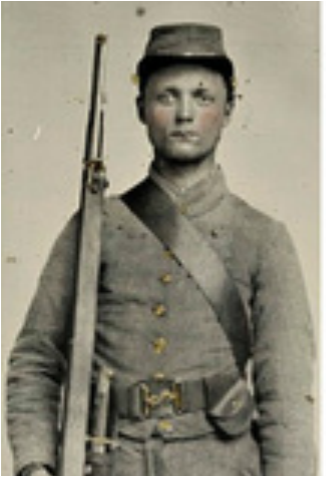
A Confederate cast silver plated brass snake belt buckle with an animal head and brass loops. The front and the back are identical and measures approximately 45 mm x 72 mm. This is the exact snake buckle, plate 209, pictured in Steve Mullinax's book,“Confederate Buckles & Plates, Expanded Edition". This relic was dug in Virginia and was once part of the famous John Turner Confederate plate collection. Mr. Turner had, at one time, the largest Confederate belt buckle collection in the country. He started collecting when he was a young man. He is retired and ultimately sold a majority of his collection to Barry Banks of Marietta, Ga. Mr. Banks is a student of the Civil War and has been metal detecting for over 40 years. He was a dealer in Civil War relics for over 20 years. I purchased this buckle form Mr. Banks and he provided a letter of authenticity. There is a superb article discussing snake buckles in the North South Trader's Magazine Vol. 35 No.2, and this particular design is featured on the cover and is described in the article.
(Reference: "Accoutrement Plates North and South 1861-1865" by William G. Gavin, pages 209-211; "Civil War Relics of the Western Campaigns" by Charles S. Harris, page 92; "Confederate General Service Accouterment Plates" by Lon W. Keim, M.D., page 292; "Excavated Artifacts from Battlefields and Campsites of the Civil War 1861-1865" by Stanley S. Phillips, page 47)
ATLANTA BUCKLE
SIMILAR BUCKLE ABOVE FOUND WHEN THEY WERE PLENTIFUL- IMAGES TAKEN FROM SYLVIA AND O' DONNELL'S CIVIL WAR RELIC BOOK
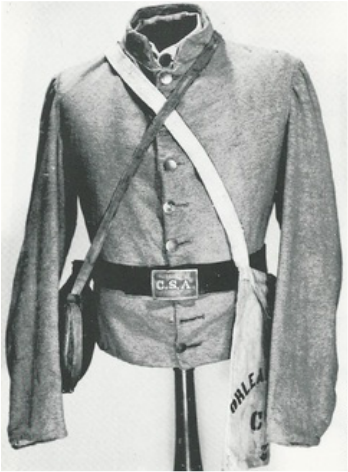
This Atlanta pattern Confederate States of America plate was dug in the 70's out of a yard in the town of Chickamauga, Georgia. This was dug at a time when you could relic hunt the sidewalks and the yards of the town.The very day it was dug it was sold to Warren of "Johny Reb Relic Shop" in Chickamauga. It was then sold the very same day to a fellow named Scott Lybrand of North Georgia. Lawrence Christopher ( Lawrence of Dalton) purchased the buckle in 2004 and he sold it to Dennis Deal of New Hope, Georgia who sold it back to Lawrence who sold it to me that same year. One of the hooks broke off which is likely why it was discarded. This is a particularly thin (3 mm) specimen and has the raised bumps on the face where the belt hooks were bent over. The plate has a twist from being underground for 100 years. This relic saw the fighting in the Atlanta campaign. The plate measures about 70 x 48 mm. Nice patina with some shine to it which I believe comes from years of constant handling. Steve Mullinax provided a letter of authenticity for this plate. This is one of the many relics I purchased from Lawrence. Mr. Christopher has passed away and with him went much of the glory days of Civil War collecting. He was one of a kind and every time I talked to him I came away with a smile and a memory. I miss dealing with him.
"Chickamauga was one of the few battles in the Civil War that the Confederates outnumbered the Union. It was the worst defeat of the Union in the Western Theatre and slowed the Union's advance to Atlanta. The armies stretched across about six miles of battle front on land that was not very good for a fight. Dense woods covered most of the battlefield, so artillery was not very useful and soldiers could only see about a half a football field distance in front of them when the day was clear - add the smoke and dust of the battle and they could barely see 20 feet in front of them. The battle lasted two days, with confusion reigning as generals struggled to keep track of their troops let alone direct them. After the first day the Union was taking a defensive position as they tried to regroup their forces. On the second day confusion among the Union generals caused a hole to open in the union line near Brotherton Cabin allowing Confederates to roll forward and two Union corps retreating from the battlefield. This left Union Major-General George H Thomas exposed and in danger. Thomas led his men in a stubborn defense on Snodgrass Hill where he earned the nickname, "The Rock of Chickamauga." After the defense, Thomas is able to make a safe and orderly retreat to Chattanooga. While the Confederates won the battle the price, like in many of the Civil War's battles was high. Killed, wounded and missing for the Confederate amounted to 18,000 of the 66,000 engaged. Union casualties were 16,000 of the 58,000 involved."
(Reference: “Confederate Buckles & Plate, Expanded Edition, ” by Steve Mullinax, plates 84-101,Confederate Arms, William A. Albaugh and Edward N. Simmons, page 176; "Plates and Buckles of the American Military 1795-1874" by Sydney C. Kerksis, pages 306-316; "The Illustrated History of American Civil War Relics" by Stephen W. Sylvia & J. O'Donnell, page 162,194, 197; "Accoutrement Plates North and South 1861-1865" by William G. Gavin, pages 97-107; "Civil War Artifacts A Guide to The Historian" by Howard Crouch, page 207; "Civil War Relics of the Western Campaigns" by Charles S. Harris, page 112, 116, 162,168, 182, 188, 192, 198, 201, 208, 223; "Arms and Equipment of the Confederacy" by Time-Life Books, page 191; "Confederate Arms" by William A. Albaugh lll and Edward N. Simmons, page 176, 177; "Civil War Collector's Encyclopedia", Volume IV, by Francis A. Lord, , page 6; "Excavated Artifacts from Battlefields and Campsites of the Civil War 1861-1865" by Stanley S. Phillips, page 46)
TONGUE OF TWO PART VIRGINA STYLE BUCKLE
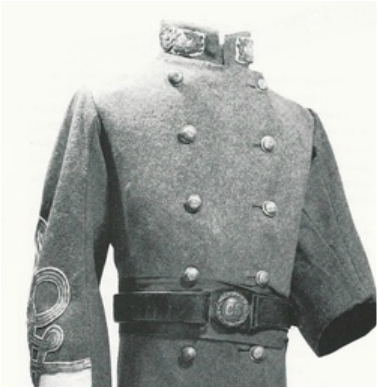 Colonel's coat of General Robert Frederick Hoke, CSA
Colonel's coat of General Robert Frederick Hoke, CSA
This tongue portion with the magic "CS" was purchased from Harry Ridgeway of Winchester VA. in 2002. Mr. Ridgeway states that this was excavated in Orange County, VA. I was fairly new to collecting Civil War buckles and handled a lot of items before I drove to Winchester to buy this one personally from Harry. At Harry's suggestion I walked this around at the Nashville Civil War show. Harry's advise to get second and third opinions was sound and with a few exceptions the dealers have been very gracious with sharing knowledge.and most have no objections to my wish to get multiple opinions. i suggest you don't deal with those few that do object. All the dealers who handled this tongue were very informative and all gave their stamp of approval. Later that week I visited Larry Hicklen's shop at Murfreesboro who inspected the relic and added the final stamp of authenticity by providing a letter attesting to the fact that it is original Civil war. It has fantastic patina and ground action and as Harry stated, " There are some buckles that you know with certainty to be correct."
(Reference: “Confederate Buckles & Plates, Expanded Edition”, by Steve Mullinax, pages plates 003 to 008, “Plates and Buckles of the American Military 1795-1874” by Sydney C. Kerksis, page 272, 449, 488 Confederate Arms, William A. Albaugh !!! and Edward N. Simmons, page 174; "Accoutrement Plates North and South 1861-1865" by William G. Gavin, pages 115- 126; " Confederate Arms" by William A. Albaugh lll and Edward N. Simmons, page 174; "Civil War Collector's Encyclopedia", Volume IV, by Francis A. Lord, , page 6)
(Reference: “Confederate Buckles & Plates, Expanded Edition”, by Steve Mullinax, pages plates 003 to 008, “Plates and Buckles of the American Military 1795-1874” by Sydney C. Kerksis, page 272, 449, 488 Confederate Arms, William A. Albaugh !!! and Edward N. Simmons, page 174; "Accoutrement Plates North and South 1861-1865" by William G. Gavin, pages 115- 126; " Confederate Arms" by William A. Albaugh lll and Edward N. Simmons, page 174; "Civil War Collector's Encyclopedia", Volume IV, by Francis A. Lord, , page 6)
PINE MOUNTAIN RELIC FRAME BUCKLE
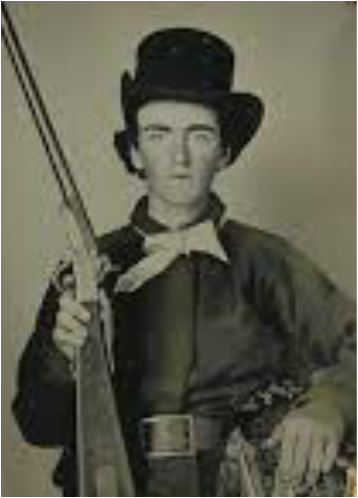
This is a portion of an original Confederate "frame" style belt buckle. This is the style that is made of a single piece of cast brass. They have two "teeth" that were designed to keep the buckle in place when they bit into the leather belt. This one is cool because it was torn apart. it was recovered in the area of Pine Mountain, Georgia near where Confederate General Polk was killed by cannon shell fire. The 3-inch solid shot that killed Episcopal Bishop and Confederate Lieutenant General Leonidas Polk on the morning of June 14, 1864, nearly tore him in half. When his mangled body was carried down from Pine Mountain, Georgia, on a litter, Private Sam Watkins of the 1st Tennessee noted that the bishop-general was ‘as white as a piece of marble,’ and ‘not a drop of blood was ever seen to come out of the place through which the cannon ball had passed.’ But plenty of blood had been spilled — advancing Union soldiers found the Georgia clay soaked with it the next day, along with a note reportedly staked by a ramrod into the ground nearby: ‘You damned Yankee sons of bitches have killed our old Gen. Polk.’ This buckle was recovered by a relic hunter named Scott Howell and came from the museum like collection of Mike Miner. I purchased it directly from Rafael Eledge of "Shiloh Relics" who provided a letter of authenticity. The digger wrote the location of the find on the side of the buckle.
(Reference: “Confederate Buckles & Plate, Expanded Edition”, by Steve Mullinax, plate 173; “Plates and Buckles of the American Military 1795-1874” by Sydney C. Kerksis, page 455, 487, 556: "The Illustrated History of American Civil War Relics" by Stephen W. Sylvia & J. O'Donnell, page 141, 160, 208; "Accoutrement Plates North and South 1861-1865" by William G. Gavin, pages 193-197; "Civil War Artifacts A Guide to The Historian" by Howard Crouch, page 223; "Civil War Relics of the Western Campaigns" by Charles S. Harris, page 60, 106, 113, 153, 201, 208, 231; "Arms and Equipment of the Confederacy" by Time-Life Books, page 190; "Confederate General Service Accoutrement Plates" by Lon W. Keim, M.D., page 147; "Excavated Artifacts from Battlefields and Campsites of the Civil War 1861-1865" by Stanley S. Phillips, page 49)
(Reference: “Confederate Buckles & Plate, Expanded Edition”, by Steve Mullinax, plate 173; “Plates and Buckles of the American Military 1795-1874” by Sydney C. Kerksis, page 455, 487, 556: "The Illustrated History of American Civil War Relics" by Stephen W. Sylvia & J. O'Donnell, page 141, 160, 208; "Accoutrement Plates North and South 1861-1865" by William G. Gavin, pages 193-197; "Civil War Artifacts A Guide to The Historian" by Howard Crouch, page 223; "Civil War Relics of the Western Campaigns" by Charles S. Harris, page 60, 106, 113, 153, 201, 208, 231; "Arms and Equipment of the Confederacy" by Time-Life Books, page 190; "Confederate General Service Accoutrement Plates" by Lon W. Keim, M.D., page 147; "Excavated Artifacts from Battlefields and Campsites of the Civil War 1861-1865" by Stanley S. Phillips, page 49)
PARTIAL ATLANTA PLATE
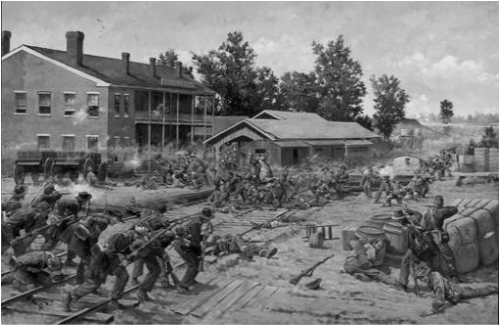 FIGHTING AT CORINTH RAILWAY JUNCTION OCTOBER 4, 1862
FIGHTING AT CORINTH RAILWAY JUNCTION OCTOBER 4, 1862
I love this plate and it gave me an opportunity to do business with one of the great guys of Civil War collecting. This is an Atlanta plate dug East of Corinth along the Memphis-Charleston Railroad line. I Purchased this from Stan Hughes of Corinth MS. in 2002.This relic could have suffered massive battle damage or it could have been laid on the tracks by a bored Confederate POW after the battle of Corinth. The former scenario is the more likely given the South's desperate need for materials at this time.Very nice patina and plenty of character. It is twisted from impact but till retains two hooks although the tip is broken off one of them.
"The First Battle of Corinth was fought on April 29-June 10, 1862 by the Union Army led by Major General Henry W. Halleck and the Confederate Army led by General P.G.T. Beauregard. This famous Civil War battle was fought between 120,000 Union soldiers and 65,000 Confederate troops. It was a victory for the Union but the Confederates maneuvering saved their army."
(Reference: “Confederate Buckles & Plate, Expanded Edition” by Steve Mullinax, plates 84-101; "Plates and Buckles of the American Military 1795-1874" by Sydney C. Kerksis, pages 306-316; "Accoutrement Plates North and South 1861-1865" by William G. Gavin, pages 97-107; "Civil War Artifacts A Guide to The Historian" by Howard Crouch, page 207 ;"Civil War Relics of the Western Campaigns" by Charles S. Harris, page 112, 116, 162,168, 182, 188, 192, 198, 201, 208, 223; "Arms and Equipment of the Confederacy" by Time-Life Books, page 191; "Confederate Arms" by William A. Albaugh lll and Edward N. Simmons, page 176,177; "Civil War Collector's Encyclopedia", Volume IV, by Francis A. Lord, , page 6; "Excavated Artifacts from Battlefields and Campsites of the Civil War 1861-1865" by Stanley S. Phillips, page 46)
"The First Battle of Corinth was fought on April 29-June 10, 1862 by the Union Army led by Major General Henry W. Halleck and the Confederate Army led by General P.G.T. Beauregard. This famous Civil War battle was fought between 120,000 Union soldiers and 65,000 Confederate troops. It was a victory for the Union but the Confederates maneuvering saved their army."
(Reference: “Confederate Buckles & Plate, Expanded Edition” by Steve Mullinax, plates 84-101; "Plates and Buckles of the American Military 1795-1874" by Sydney C. Kerksis, pages 306-316; "Accoutrement Plates North and South 1861-1865" by William G. Gavin, pages 97-107; "Civil War Artifacts A Guide to The Historian" by Howard Crouch, page 207 ;"Civil War Relics of the Western Campaigns" by Charles S. Harris, page 112, 116, 162,168, 182, 188, 192, 198, 201, 208, 223; "Arms and Equipment of the Confederacy" by Time-Life Books, page 191; "Confederate Arms" by William A. Albaugh lll and Edward N. Simmons, page 176,177; "Civil War Collector's Encyclopedia", Volume IV, by Francis A. Lord, , page 6; "Excavated Artifacts from Battlefields and Campsites of the Civil War 1861-1865" by Stanley S. Phillips, page 46)
PARTIAL ROPE BOARDER PLATE AND BULLET
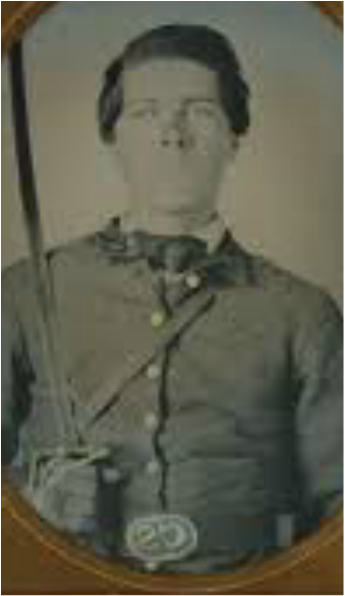
Another partial plate acquired from the late Stan Hughes of Corinth, MS.This is the plate referred to as a Rope Boarder and noted for its simple letters with an inner border giving the appearance of twisted rope. Plate is stamped on thick sheet brass and scraps of brass were cut into hooks and soldered into place. The plate never was lead filled. It was dug together with a carved .69 French triangle bullet (pictured). I guess this soldier was bored with nothing else to do so he widdled away at the bullet.This is the "S" half of the buckle with an appealing patina. The back retains part of the hook. Mr. Hughes couldn't remember the name of the digger who discovered this relic but he stated that the fellow came in from Alabama and hunted with a buddy of his several years before I purchased it. They found this artifact South-East of Corinth in a CS POW camp.
" The following is a Portion of an article in The Weekly Democrat of Natchez, which was published on May 14, 1866. The writer was not identified - "In the North western angle, formed by the crossing of the railroads, from Corinth out to and beyond the outer line of works, three and a half miles distant, the whole of this great battle-ground is dotted, here and there – in some places thick as meadow mole-hills – with the graves of Federal and the exposed remains of Confederate dead."
Stan is another fellow that I miss. I always enjoyed dealing with him and he never hesitated to share his extensive knowledge.
(Reference: “Confederate Buckles & Plate, Expanded Edition ” by Steve Mullinax, plates 140; "Confederate Arms" by William A. Albaugh !!! and Edward N. Simmons, page 177; "Plates and Buckles of the American Military 1795-1874" by Sydney C. Kerksis, pages 277; "The Illustrated History of American Civil War Relics" by Stephen W. Sylvia & J. O'Donnell, page 207; "Accoutrement Plates North and South 1861-1865" by William G. Gavin, page 86; "Civil War Artifacts A Guide to The Historian" by Howard Crouch, page 204; "Civil War Relics of the Western Campaigns" by Charles S. Harris, page 76, 113, 128, 152; "Confederate Arms" by William A. Albaugh lll and Edward N. Simmons, page 177; "Civil War Collector's Encyclopedia", Volume IV, by Francis A. Lord, , page 6; "Excavated Artifacts from Battlefields and Campsites of the Civil War 1861-1865" by Stanley S. Phillips, page 45)
" The following is a Portion of an article in The Weekly Democrat of Natchez, which was published on May 14, 1866. The writer was not identified - "In the North western angle, formed by the crossing of the railroads, from Corinth out to and beyond the outer line of works, three and a half miles distant, the whole of this great battle-ground is dotted, here and there – in some places thick as meadow mole-hills – with the graves of Federal and the exposed remains of Confederate dead."
Stan is another fellow that I miss. I always enjoyed dealing with him and he never hesitated to share his extensive knowledge.
(Reference: “Confederate Buckles & Plate, Expanded Edition ” by Steve Mullinax, plates 140; "Confederate Arms" by William A. Albaugh !!! and Edward N. Simmons, page 177; "Plates and Buckles of the American Military 1795-1874" by Sydney C. Kerksis, pages 277; "The Illustrated History of American Civil War Relics" by Stephen W. Sylvia & J. O'Donnell, page 207; "Accoutrement Plates North and South 1861-1865" by William G. Gavin, page 86; "Civil War Artifacts A Guide to The Historian" by Howard Crouch, page 204; "Civil War Relics of the Western Campaigns" by Charles S. Harris, page 76, 113, 128, 152; "Confederate Arms" by William A. Albaugh lll and Edward N. Simmons, page 177; "Civil War Collector's Encyclopedia", Volume IV, by Francis A. Lord, , page 6; "Excavated Artifacts from Battlefields and Campsites of the Civil War 1861-1865" by Stanley S. Phillips, page 45)
POOR MAN'S AUTHENTIC CONFEDERATE BUCKLE
This is a great beginners buckle that many diggers would have thrown away in the early days of collecting. It is small piece of a pewter plate less than 40 mm at its widest but this relic is as historically important and correct as a $3,500 complete CS buckle. It was included in a small collection of Corinth/Shiloh items I purchased from Stan Hughes. It is clearly the corner of a pewter Confederate buckle. The reverse shows where one of the hooks was attached. It surely "saw the elephant" and has all the history, authenticity and rarity of any CS buckle and is as interesting as any buckle you could hold in your hand.
(Reference: “Confederate Buckles & Plates ,Expanded Edition ” by Steve Mullinax, plate 197; "Civil War Relics of the Western Campaigns" by Charles S. Harris, pages 63,117)
(Reference: “Confederate Buckles & Plates ,Expanded Edition ” by Steve Mullinax, plate 197; "Civil War Relics of the Western Campaigns" by Charles S. Harris, pages 63,117)
Rare CSA Pewter Belt Plate Portion
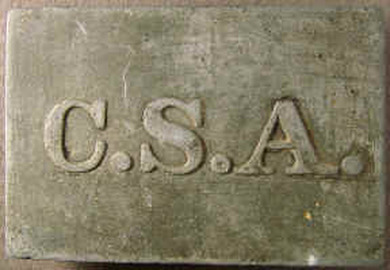
This excavated relic is approximately one third of a complete and very rare Confederate belt buckle and because of its manufacture almost never found complete. A complete buckle depicts "CSA" and is a rectangle belt plate used in the Confederacy. This style is cast of pewter, and does not bear a border. These are believed to have been made in Rome, Georgia and were primarily supplied to western troops. Durability was a problem and often would simply break into pieces. Plate is cast and the wire hooks were soldered into place. The back is sometimes marked with lines to accurately place the hooks. The plate, when found complete, measures about 50 mm X 75 mm. Constructed of solid sand cast pewter, this particular portion has the raised letter "A" and the back still retains one of the three iron wire belt attachment hooks which is completely bent over to the plate.This relic was recovered at Port Hudson, LA and has not been repaired.
"In cooperation with Maj. Gen. Ulysses S. Grant’s offensive against Vicksburg, Union Maj. Gen. Nathaniel P. Banks’s army moved against the Confederate stronghold at Port Hudson on the Mississippi River. On May 27, after their frontal assaults were repulsed, the Federals settled into a siege which lasted for 48 days. Banks renewed his assaults on June 14 but the defenders successfully repelled them. On July 9, 1863, after hearing of the fall of Vicksburg, the Confederate garrison of Port Hudson surrendered, opening the Mississippi River to Union navigation from its source to New Orleans."
While this plate portion is in solid condition, there is some moderate pitting. An example of this plate can be found in Steve Mullinax's book "Confederate Belt Buckles and Plates", 1st edition, on page 55 as plate 094 (also in "Expanded Edition" of the same book on page 67, plate 112). According to Mullinax's description, "As a result of the inferior metal, these are usually cracked when found. Evidence points toward manufacture in Rome, Georgia by the Noble Brothers foundry." This is an excellent and rare Confederate buckle, even if it's a portion. It measures about 50 x 36 mm.
(Reference: "Civil War Artifacts A Guide to The Historian" by Howard Crouch, page 207; "Plates and Buckles of the American Military 1795-1874" by Sydney C. Kerksis, page 323; "Accoutrement Plates North and South 1861-1865" by William G. Gavin, page 104; “Confederate Buckles & Plate, Expanded Edition” by Steve Mullinax, plate 67; "Excavated Artifacts from Battlefields and Campsites of the Civil War 1861-1865" by Stanley S. Phillips, page 46)
"In cooperation with Maj. Gen. Ulysses S. Grant’s offensive against Vicksburg, Union Maj. Gen. Nathaniel P. Banks’s army moved against the Confederate stronghold at Port Hudson on the Mississippi River. On May 27, after their frontal assaults were repulsed, the Federals settled into a siege which lasted for 48 days. Banks renewed his assaults on June 14 but the defenders successfully repelled them. On July 9, 1863, after hearing of the fall of Vicksburg, the Confederate garrison of Port Hudson surrendered, opening the Mississippi River to Union navigation from its source to New Orleans."
While this plate portion is in solid condition, there is some moderate pitting. An example of this plate can be found in Steve Mullinax's book "Confederate Belt Buckles and Plates", 1st edition, on page 55 as plate 094 (also in "Expanded Edition" of the same book on page 67, plate 112). According to Mullinax's description, "As a result of the inferior metal, these are usually cracked when found. Evidence points toward manufacture in Rome, Georgia by the Noble Brothers foundry." This is an excellent and rare Confederate buckle, even if it's a portion. It measures about 50 x 36 mm.
(Reference: "Civil War Artifacts A Guide to The Historian" by Howard Crouch, page 207; "Plates and Buckles of the American Military 1795-1874" by Sydney C. Kerksis, page 323; "Accoutrement Plates North and South 1861-1865" by William G. Gavin, page 104; “Confederate Buckles & Plate, Expanded Edition” by Steve Mullinax, plate 67; "Excavated Artifacts from Battlefields and Campsites of the Civil War 1861-1865" by Stanley S. Phillips, page 46)
CONFEDERATE ATLANTA PLATE
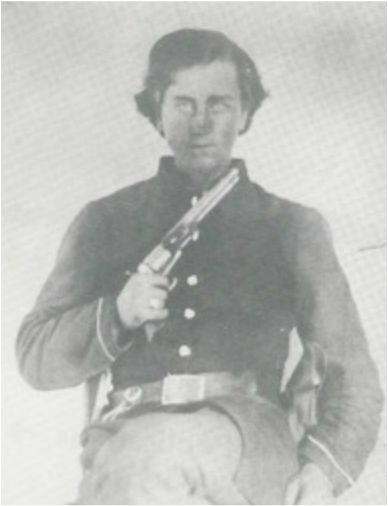
This is a thick "Atlanta" style Confederate belt buckle with "deep woods" patina. It still has all three hooks, great body curve and exceptional overall condition. This was dug in Dalton, Georgia in 2007. This belt plate would have been produced by the Atlanta Arsenal for Georgian troops and the Army of Tennessee between 1862 and 1864. The arsenal was established in March 1862 after Nashville fell to Union troops and the supplies, facilities, and personnel were removed to Atlanta. The new arsenal that was established was a large facility that eventually had thirteen buildings and employed some five thousand workers. The Atlanta Arsenal was closed when Union General William T., Sherman advanced on Atlanta in August 1864. This is a great buckle but I traded this relic as part of the deal to acquire the Atlanta plate on its original belt shown above.
(Reference: “Confederate Buckles & Plate, Expanded Edition, ” by Steve Mullinax, plates 84-101,Confederate Arms, William A. Albaugh !!! and Edward N. Simmons, page 176; "Plates and Buckles of the American Military 1795-1874" by Sydney C. Kerksis, pages 306-316; "The Illustrated History of American Civil War Relics" by Stephen W. Sylvia & J. O'Donnell, page 162,194, 197; "Accoutrement Plates North and South 1861-1865" by William G. Gavin, pages 97-107; "Civil War Artifacts A Guide to The Historian" by Howard Crouch, page 207; "Civil War Relics of the Western Campaigns" by Charles S. Harris, page 112, 116, 162,168, 182, 188, 192, 198, 201, 208, 223; "Arms and Equipment of the Confederacy" by Time-Life Books, page 191; "Confederate Arms" by William A. Albaugh lll and Edward N. Simmons, page 176, 177; "Civil War Collector's Encyclopedia", Volume IV, by Francis A. Lord, , page 6; "Excavated Artifacts from Battlefields and Campsites of the Civil War 1861-1865" by Stanley S. Phillips, page 46)
(Reference: “Confederate Buckles & Plate, Expanded Edition, ” by Steve Mullinax, plates 84-101,Confederate Arms, William A. Albaugh !!! and Edward N. Simmons, page 176; "Plates and Buckles of the American Military 1795-1874" by Sydney C. Kerksis, pages 306-316; "The Illustrated History of American Civil War Relics" by Stephen W. Sylvia & J. O'Donnell, page 162,194, 197; "Accoutrement Plates North and South 1861-1865" by William G. Gavin, pages 97-107; "Civil War Artifacts A Guide to The Historian" by Howard Crouch, page 207; "Civil War Relics of the Western Campaigns" by Charles S. Harris, page 112, 116, 162,168, 182, 188, 192, 198, 201, 208, 223; "Arms and Equipment of the Confederacy" by Time-Life Books, page 191; "Confederate Arms" by William A. Albaugh lll and Edward N. Simmons, page 176, 177; "Civil War Collector's Encyclopedia", Volume IV, by Francis A. Lord, , page 6; "Excavated Artifacts from Battlefields and Campsites of the Civil War 1861-1865" by Stanley S. Phillips, page 46)
REPRODUCTION BUCKLES
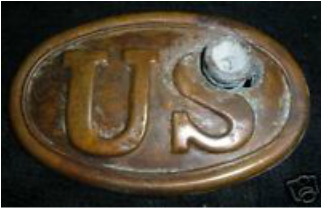 one of the more obvious fakes
one of the more obvious fakes
There are numerous Civil War buckle reproductions being sold. Some are much better quality than others and are great items for display. Unfortunately there is no shortage of unscrupulous people willing and ready to offer an artificially aged buckle as original. Some of the most reputable people in the collecting community have been fooled and there has been the creation of lasting bitterness between good people because of this. New collectors should be extremely cautious when purchasing a buckle, and in particular, a CS buckle. There is nothing worse than spending your hard earned money on what has been sold as a historic piece and later having some doubts when you hold it in your hand. Take your time, get lots of opinions, buy from reputable people and most of all.......educate yourself.
(Reference: Repo Buckles of the Civil War by Howard Crouch; “Plates and Buckles of the American Military 1795-1874” by Sydney C. Kerksis, pages 489-506)
(Reference: Repo Buckles of the Civil War by Howard Crouch; “Plates and Buckles of the American Military 1795-1874” by Sydney C. Kerksis, pages 489-506)
